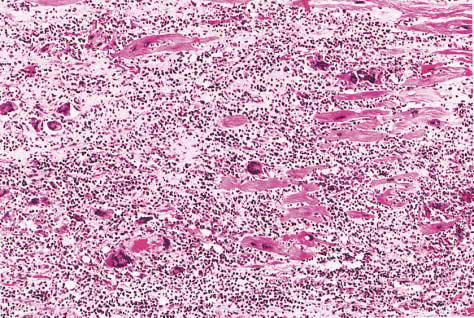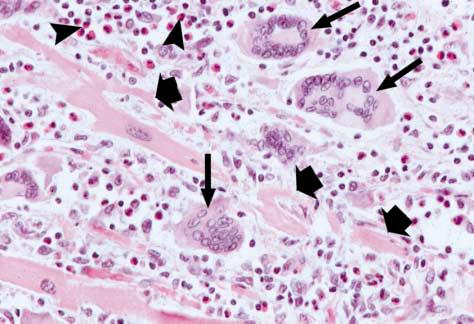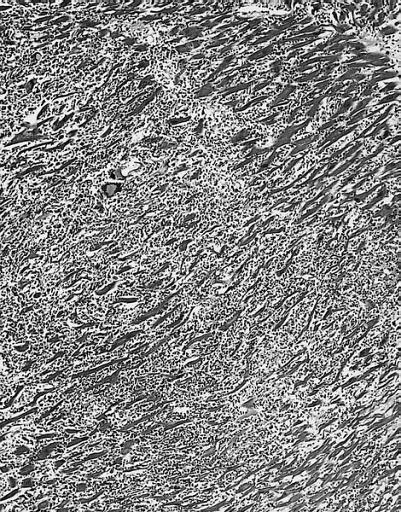Giant cell myocarditis


Editor-In-Chief: C. Michael Gibson, M.S., M.D. [1]; Associate Editor: Cafer Zorkun, M.D., Ph.D. [2]
Overview
Giant cell myocarditis (GCM) or Idiopathic Giant cell myocarditis (IGCM) is a rare but often fatal inflammatory process involving the myocardium. Other than cardiac transplantation, there is no known cure for giant cell mycoarditis.
Pathophysiology
because of the unknown nature of the disorder. GCM is usually characterized by progressive congestive heart failure, and is frequently associated with refractory ventricular arrhythmias. The majority of patients die secondary to congestive heart failure, although some have survived for long periods, often after immunosuppressive treatment. [1] [2]
This disease often affects young otherwise healthy individuals. The rate of death or heart transplantation is approximately 70% at one year. Data from a Lewis Rat model and from observational human studies suggest that GCM is mediated by T lymphocytes and may respond to treatment aimed at attenuating T cell function.
Numerous autoimmune disorders have been associated with giant-cell myocarditis in case reports, but no data have been available on the incidence of these disorders in a study population with giant-cell myocarditis.
The Giant Cell Myocarditis Registry is a clinical and pathologic database from 63 cases of giant cell myocarditis gathered from 36 medical centers. Findings from the registry include the following: the sensitivity of endomyocardial biopsy for GCM for patients who undergo transplantation or autopsy is approximately 80%. Registry subjects who received cyclosporine and/or azathioprine, with steroid and sometimes muromonab-CD3 had prolonged transplant-free survival (12.6 months vs 3.0 months for no immunosuppression.[3].
Gross Pathological Findings
Images shown below are courtesy of Professor Peter Anderson DVM PhD and published with permission. © PEIR, University of Alabama at Birmingham, Department of Pathology
-
Giant Cell Myocarditis: Gross dilated LV with focal fibrosis
-
Giant Cell Myocarditis: Gross dilated LV with focal fibrosis
-
Giant Cell Myocarditis: Gross dilated LV with focal fibrosis
Microscopic Pathological Findings
Images shown below are courtesy of Professor Peter Anderson DVM PhD and published with permission. © PEIR, University of Alabama at Birmingham, Department of Pathology
-
Boecks Sarcoid Giant Cell Myocarditis
-
Boecks Sarcoid Giant Cell Myocarditis
-
22-year-old man was seropositive for HIV-1 and died suddenly. There was widespread inflammation of the myocardium with giant cells, resembling giant cell myocarditis, that may have represented a precursor to lymphoma.
Natural History, Complications, and Prognosis
Post-transplantation survival is approximately 71% at five years despite a 25% rate of giant cell infiltration in the donor heart.
These findings should be confirmed with a randomized trial of immunosuppression including muromonab-CD3, cyclosporine, and steroids.
Giant cell myocarditis may recur after transplantation but may respond to augmented immunosuppression.
References
- ↑ Desjardins V, Pelletier G, Leung TK, Waters D. Successful treatment of severe heart failure caused by idiopathic giant cell myocarditis. Can J Cardiol 1992;8:788-92
- ↑ Ren H, Poston RS Jr, Hruban RH, Baumgartner WA, Baughman KL, Hutchins GM. Long survival with giant cell myocarditis. Mod Pathol 1993;6:402-7.
- ↑ Cooper LT, Berry GJ, Shabetai R.Idiopathic Giant-Cell Myocarditis — Natural History and Treatment. N Engl J Med. 1997 Jun 26;336(26):1860-6





